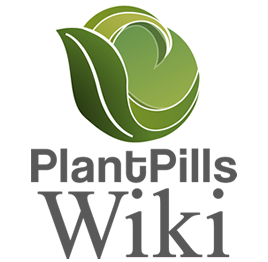
A photo of the PlantPills Spirulina Tablets and Powder. For more photos, please see the desktop version of this page here.
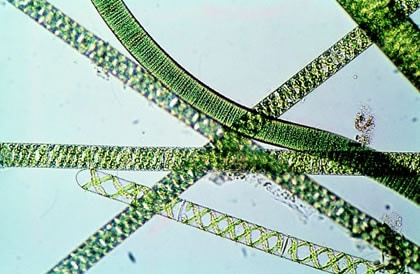 Spirulina is a tiny single-celled blue-green alga that lives in fresh water. It's a plant that has existed on earth for over 3 billion years, is about half a millimetre in length, and appears under a microscope as long, thin, blue-green spiral threads. Strong sunlight, pure water and clean air enable spirulina to thrive, but it is highly adaptable, and is known to survive in extremely harsh conditions.
Spirulina is a tiny single-celled blue-green alga that lives in fresh water. It's a plant that has existed on earth for over 3 billion years, is about half a millimetre in length, and appears under a microscope as long, thin, blue-green spiral threads. Strong sunlight, pure water and clean air enable spirulina to thrive, but it is highly adaptable, and is known to survive in extremely harsh conditions.Spirulina is said to have been consumed in Mexico City as the primary source of protein for 5,000 years. Today, millions of people worldwide use spirulina daily, but it is most commonly consumed in the far east; Japan is the world's largest consumer.
Spirulina is considered one of the most nutritious foods on Earth, and NASA has used spirulina for astronauts in space. In the 1974 United Nations World Food Conference, it was announced that spirulina is “the most ideal food for mankind”. The World Health Organisation considers it "a very suitable food” and “able to be administered to children without any risk”, while The United Nations has said “there is a need for both national governments and inter-governmental organizations to re-evaluate the potential of spirulina to fulfil both their own food security needs as well as a tool for their overseas development emergency response efforts”.
PlantPills spirulina is an extremely nutritious whole food, and is packed with vitamins, minerals, omega 6/9 fatty acids, RNA, DNA, polysaccharides, the age-fighting antioxidant enzyme superoxide dismutase (SOD), and chlorophyll, amongst others.
Spirulina has a particularly high Oxygen Radical Absorbance Capacity (ORAC) level, and is one of the highest sources of phytopigments such as beta-carotene and zeaxanthin, but is the only known source of phycocyanin, which makes up about 16% of spirulina’s weight and is known to have antioxidant, anti-inflammatory, neuro/hepto-protective, and anti-tumour properties.
PlantPills spirulina is between 60 and 70% protein, and this protein is in a pre-digested form, meaning that it is extraordinarily easy to digest, resulting in an unmatched digestibility coefficient of 95%. Unlike most foods, spirulina's cell walls are a very thin complex of natural sugars which practically dissolve upon contact with moisture and digestive enzymes.
Within moments, it is absorbed by the body, without the loss of time and energy incurred in the digestion of ordinary foods.
Spirulina has extremely high levels of EAAs (essential amino acids) that we must obtain from food, and BCAAs (branched-chain amino acids), and because the amino acids in spirulina are delivered in an essentially “free-form” state, there is almost instantaneous assimilation, allowing rapid protein synthesis.
BCAAs are often used to improve exercise performance and recovery, and to reduce muscle breakdown. It is no surprise that these are some of the benefits observed in studies involving athletes.
PlantPills spirulina has a particularly high omega 6 essential fatty acid GLA content, in amounts comparable to purpose built supplements that use extracts and isolates, and yet spirulina is a vegetarian whole food.
Spirulina is a potent mixture of antioxidants and most of Spirulina’s health benefits are associated with its antioxidant pigments. These are carotenoids (mixture of carotenes and xanthophylls), chlorophyll and the unique blue pigment phycocyanin. Among these pigments, the xanthophyll zeaxanthin is rare in nature, and 3 g Spirulina can provide adequate quantities of this very valuable xanthophyll. Phycocyanin is even rarer in our diet and 3 g Spirulina can provide adequate quantities of this highly beneficial pigment.
Spirulina is the world's best source of the anti-oxidant superoxide dismutase (SOD). The superoxide molecule is one of the most tissue damaging substances within the body. SOD is a biological adaptation specifically designed to destroy the superoxide radical and to protect against any subsequent tissue damage. Inadequate superoxide dismutase formation leads to accelerated aging and tissue degeneration.
Spirulina is very rich in carotenoid anti-oxidants. It has 22 times the amount of beta carotene (a form of vitamin A) per volume of carrots. Spirulina also contains high levels of zeaxanthin and lutein. These antioxidants are very important for good vision and overall eye health.
According to a study by Orient Medical Science University of Japan, dietotherapy with spirulina had an 80% effectiveness on 480 cases of senile cataracts, diabetic retinopathies, and hypertensive retinopathies.
Spirulina is a powerful blood cleanser due to its rich source of chlorophyll. It contains roughly ten times the amount of chlorophyll in green vegetables per volume. Chlorophyll helps build red blood cells in the body and provides an easily absorbable form of magnesium. This combination helps oxygenate the blood stream and removes organic toxins.
Phycocyanin and allophycocyanin, which help to form the blue colour within spirulina (along with anthocyanins), have been shown to increase white blood cell counts.
A second 2002 study at Havana’s Ozone International Center showed that phycocyanin from spirulina acted as an anti-inflammatory in protecting live mice which had been injected with arthritis-inducing Zymosan. The mice showed no cartilage damage and an inhibited inflammatory response after receiving spirulina for eight days following their Zymosan injections. The animal nutritionals maker Pharma Chemie of Syracuse, NY has since gone on to patent a compound containing phycocyanin, which gives spirulina its blue-green color, as an anti-inflammatory for use in animals.
The combination of SOD and carotenoids within spirulina make it very good for skin care. It is renowned for improving ageing spots, eczema, acne, & rashes.
Spirulina has strong anti-microbial effects that help create balance in the gut flora. It does this by controlling the growth of pathogenic bacterialike e-coli and yeasts in the digestive system. This is critical for optimal digestion and nutritional absorption because healthy flora increase absorption of nutrients from the foods we eat, and protect against infection.
A study published in the May 2005 issue of the journal Experimental Neurology found that the brains of aged rats fed spirulina supplements maintained their neuron function much better, and showed far less free radical damage than those of rats fed cucumbers. The research is significant because it indicates that spirulina may be helpful in warding off the free radical damage related to aging diseases like Parkinson’s and Huntington’s Disease.
Spirulina is a rich source of the tough to find essential omega-6 fat GLA. The human brain is around 80% fat, and tissues in the brain require fatty acids such as GLA for brain function and growth. Human breast milk contains high quantities of GLA because infants need to build brain mass quickly in order to boost their chances of survival. A bigger, better brain improves a child's ability to comprehend language, and helps with social interactions, environmental cues, and interpreting sensory input.
Several studies involving mice and dogs have shown that spirulina provides protection against genetoxicity induced by cisplatin, urethane, cyclophosphamide and mitomycin-C, and consistently increased the level of red cells, white cells, and haemoglobin in blood and nucleated cells/DNA in bone marrow. Polysaccharide from spirulina reduced hematopoietic damage induced by cyclophosphamide and Cobalt-60 irradiation.
In a study published in 2010 by PLoS One, spirulina appeared to enhance stem cell proliferation in rats.
In a study published in 2013 by PLoS One, spirulina preserved testosterone levels in rats exposed to oxidative toxins known to reduce testosterone levels. It is also noteworthy that the group given spirulina without being exposed to the toxin did not experience an increase in testosterone levels.
This suggests that spirulina is able to maintain normal testosterone levels when a toxin is present, and if no toxin is present, it does not affect testosterone levels.
A study in 1995 by Universidad Centro Americano found an 81 percent improvement in academic scores when children took just one gram of spirulina every day for six months.
A study published in the December 2000 issue of Acta Psychiatrica Scandinavica, in which 109 children took one gram of blue-green algae daily for 10 weeks, found most of the children showed significant improvement in their ability to focus, concentrate, and follow directions.
A study published in Ibnosina Journal of Medicine and Biomedical Sciences in 2010, found that supplementing with 2 g spirulina per day for 8 weeks was able to increase muscle size and strength of subjects compared to those receiving a placebo.
Another study, published in Medicine & Science in Sports & Exercise in 2009, found that supplementing with 6 g of spirulina per day for 4 weeks was able to increase exercise performance, fat oxidation, and reduce oxidative damage by free radicals.
The men ran on a treadmill for two hours every day, running at 70-75% of their VO2 max and 95% of their VO2 max to exhaustion. Both exercise performance and respiratory function were measured. Blood samples were drawn at regular intervals during the study. The time to fatigue after the two hour run was significantly longer among the men who took spirulina. The carbohydrate oxidation rate was decreased by over 10% and the fat burning rate was increased by almost 11% over the placebo group. The study concluded that spirulina really does enhance exercise performance.
A 1998 study published in XXIV FIMS World Congress of Sports Medicine in June 1998, found that supplementing with spirulina tablets resulted in an improvement in iron reserves, which can optimize athletes' health and physical capacity. Clinical symptoms such as exhaustion, muscle fatigue and somnolence, which can be a result of depleted iron reserves, were reduced after supplementation with spirulina, and the resulting correction of the iron deficiency.
A 2006 study published in the journal Applied Physiology found that ingestion of spirulina in addition to normal diet showed a preventive effect of the skeletal muscle damage following exercise, and that probably led to postponement of the time of exhaustion during the all-out exercise.
Spirulina has been used as a health food supplement for malnourished children and adults in clinical studies since the early 1970s.
In 1993, India had a one year feeding program of 1 gram per day of spirulina with 5,000 preschool children for at least 150 days, and found that the spirulina supplemented diet reduced the occurrence of "Bitot's spot", a symptom of vitamin A deficiency, from 80% to 10%
Spirulina works so well at mitigating the damage caused by radiation that it was actually awarded a Russian patent in 1995 for improving the immunity of children affected by radiation from the Chernobyl disaster. Many children became stricken with chronic radiation sickness and elevated Immunoglobulin E (IgE) levels, and they also tested positive for high allergy sensitivity. But upon consuming roughly five grams (g) of Spirulina a day for 45 days, the children's IgE levels and allergic sensitivities were restored back to normal.
A 2001 study conducted by researchers from the Medical and Pharmaceutical Academe of Yangzhou University in China found that Spirulina extracts effectively protect against both the damage caused by chemotherapy drugs and the damaging effects of gamma radiation exposure.
A study published in the Life Sciences journal in 1993 found that increases in hepatic triglyceride levels in rats fed fructose were reduced significantly by supplementation with spirulina.
A study in 1987 by Tokyo Medical and Dental University found that hypochronic anaemia was successfully treated (haemoglobin content increased 21% from 10.9 to 13.2) after subjects took 4 grams of spirulina after each meal for 30 days.
A 2011 study suggests that spirulina may help boost a weakened immune system and reduce the risk of anaemia in the elderly. Forty adults, aged 50 and over, with no chronic diseases, took 3g of spirulina daily for 12 weeks.
After 6 and 12 weeks of therapy, the researchers performed complete blood cell counts, and found that spirulina led to increases in IDO activity and haemoglobin. The authors concluded that "spirulina may ameliorate anaemia and immunosenescence in older subjects".
A study published in Experimental Neurology in 2005 found that after a stroke, rats fed a spirulina enriched diet had stroke lesions that were 75% smaller than those in the control group. The rats fed spirulina also recovered mobility to a greater extent.
A randomized, double-blind clinical study published in the Spring 2005 isssue of the Journal of Medicinal Food indicated that allergic rhinitis (nasal allergy) sufferers given a daily 2 g dose of spirulina for twelve weeks, made a significant improvement in their allergy symptoms. There was no improvement for the participants taking the placebo.
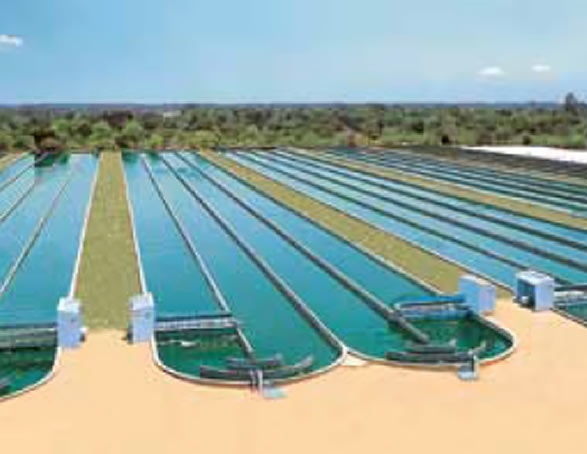
PlantPills spirulina is grown in vast mineral rich fresh water “raceway” type ponds by Parry Nutraceuticals in India, the only spirulina producer in the world to be certified by the U.S. Pharmacopeial Convention (USP) under their Dietary Ingredient Verification Program. Parry have been cultivating spirulina for over 30 years, and are acknowledged to be among the very best producers of spirulina in the world.
PlantPills spirulina (Arthrospira platensis) contains more gamma linolenic acid (GLA), vitamin K, vitamin B2, chlorophyll and crude phycocyanin than any other known source in the world.
A concern for anyone who consumes spirulina is the potential contamination of spirulina with blue green algae strains of AFA (Aphanizomenon flos-aquae), some of which produce microcystins, which are known to be hepatoxic (toxic to the liver) and carcinogenic (cancer causing).
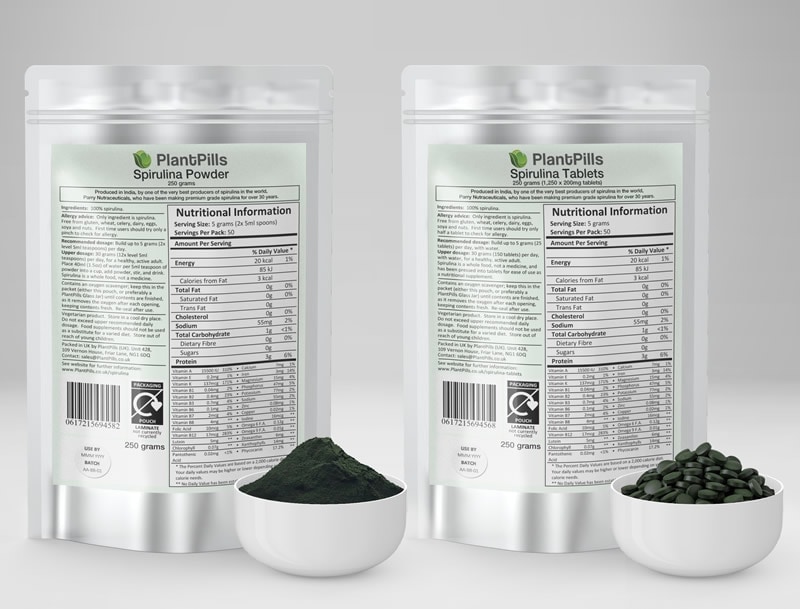
PlantPills spirulina tests negative for microcystins, at a stringent detection limit of half a part per billion. It also tests negative for the neurotoxin BMAA. Frankly, if every batch of spirulina is not tested to this level, it cannot be deemed certain to be safe for human consumption.
PlantPills spirulina is cultivated using vegetarian organic nutrients (no animal products or Chilean Nitrate are added), is suitable for vegans, is non-GMO, is gluten free, herbicide and pesticide free, and although Parry have obtained organic certifications from USDA and OCIA (USA), Ecocert (France), and Naturland (Germany), PlantPills has not yet applied for organic certification in the UK, so we can not yet claim that our spirulina is organic, and do not sell it as organic.
PlantPills spirulina comes in powder or 200 mg tablets, significantly smaller and easier to take than the larger 500mg supplied by the majority of producers.
Every batch of PlantPills Spirulina is independently verified by third-party laboratories to have no dangerous levels of heavy metals or micro-organisms. The certifications for the current batch are viewable below. Every single batch is thoroughly tested in-house to confirm the absence of BMAA/microcystin.
Pack sizes are 250 grams, 500 grams, 1 kilogram, 2 kilograms and 10 kilograms (selectable in the basket).
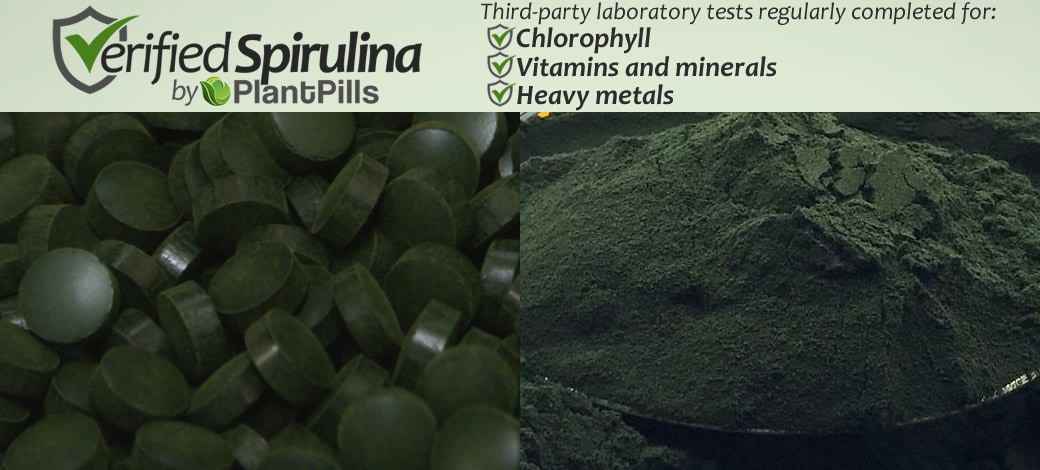
USP Verified |
ISO GMP 14001/9001 |
ISO 22000 |
Certified Halal |
Certified Kosher |
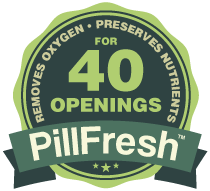 It is imperative that spirulina is transported and stored in an oxygen-free environment, even after opening. If spirulina is exposed to oxygen, the nutritional value quickly starts to diminish, because vitamins, enzymes and antioxidants are particularly sensitive to oxygen.
It is imperative that spirulina is transported and stored in an oxygen-free environment, even after opening. If spirulina is exposed to oxygen, the nutritional value quickly starts to diminish, because vitamins, enzymes and antioxidants are particularly sensitive to oxygen.PlantPills spirulina is supplied in our unique PillFresh™ packaging, which keeps the spirulina sealed in an environment with an oxygen content of less than 0.1%. After you open your PlantPills spirulina, just seal it back up, and incredibly, our unique PillFresh™ packaging will again reduce the oxygen content to less than 0.1%, continuing to keep the spirulina fresh.
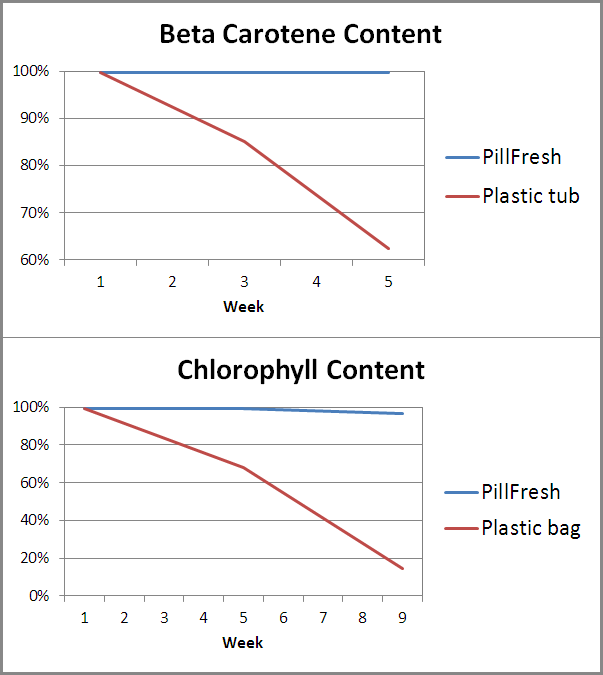
This packaging will continue to do this time and time again, for 40 openings.
Other vendors package spirulina tablets in plastic tubs, or "vacuum sealed" aluminium pouches. Plastic tubs are permeable to oxygen, so are no use for keeping spirulina fresh. Tablets in aluminium pouches are difficult to vacuum seal, and this type of vacuum sealing typically contains at least 2% oxygen. This is enough oxygen to start diminishing the nutritional value, and considering mould can grow in air with a 0.3% oxygen content, this really isn't acceptable.
It is therefore pretty certain that a significant amount of nutrition is lost before a typical package of spirulina is even opened by the consumer. Then, after opening, the exposure to oxygen quickly starts to diminish the nutritional value further. While our PillFresh packaging maintains 100% (or very close to 100%) of the nutrients, typical packaging will result in a 37% loss in beta carotene content after four weeks, and an 85% loss in chlorophyll content after 8 weeks.
PillFresh™ packaging is truly innovative, and exclusive to PlantPills.
The best quality spirulina comes from reputable companies which have been producing spirulina for decades. Such companies have vast experience and knowledge of growing, harvesting and processing good quality spirulina. They will provide Certificate of Analysis' (COAs), completed by third party testing labs. This ensures the spirulina is of a high quality and is safe.
If the vendor or retailer of the spirulina for sale can not or will not provide you with the name of the producer, and a COA from a third party (a document from the testing lab, NOT the producer or vendor), do not buy the spirulina.
With no producer or valid COA (not just numbers typed into a website or an email from the vendor), you really don’t know what you are buying. It doesn’t matter if it’s even labelled as organic, from “pristine waters of Hainan, China”, or have impressive looking claims on their website, you really don’t know what you are buying.
An analysis of contaminated algae product for sale (by the FDA in America) found adult flies and adult fly fragments, maggots and maggot fragments, ants and ant fragments, cicada and cicada fragments, hundreds of other insect fragments, ticks, mites, ostracods, rat or mouse hairs, bird feathers, and water fleas.
In 2008, a Chinese milk scandal was exposed in which 6 babies died and hundreds of thousands of others became ill after melamine was added to raw milk to make it appear higher in protein. This further damaged China’s reputation for producing safe and reliable food products.
Spirulina from China is the cheapest available, and is often classified as organic. However, the "organic" classification has no relevance to nutritional content, purity, or contamination.
The fact is that without even knowing the producer, and without having regular nutritional and safety analysis from a reputable third party laboratory, spirulina from China (or anywhere else for that matter) is not a verifiable, reliable, good quality source of safe spirulina.
Spirulina is a whole food, not a medicine, so there is no upper dose. Many people who supplement their diet with spirulina do not take enough for it to be effective.
Human studies have shown that spirulina is safe for human consumption and daily consumption of approximately 4 g per kg of body weight did not result in any adverse effects, even in infants and young children. No member of the genus spirulina is known to be toxic.
Spirulina is a natural cleanser and helps to eliminate toxins from the body, especially when it is first taken. Some people may experience changes in their digestive systems for the first few days of taking spirulina. These changes are temporary, and things should be back to normal within a number of days.
Recommended dosage: Build up to 5 grams (25 tablets/2x level 5ml teaspoons of powder) per day, with water.
Upper dosage: 30 grams (150 tablets/12x level 5ml teaspoons of powder) per day, with water, for a healthy, active adult.
Normal maintenance dose for a healthy, active adult can be 15-30 grams (75-150 tablets) per day, split at different times of the day.
To consume the powder, place 40ml (1.5oz) of water per 5ml teaspoon of powder into a cup, add powder, stir, and drink. Vigorous stirring with a fork may be required, as spirulina can be prone to clumping.
Some people like to take spirulina in one go, and some like to split their dosage up between 2-3 times during the day.
Some people like to take spirulina before eating, some with their meals, and some between meals. It doesn't really matter; whichever is most convenient and effective.
It is common, and perfectly fine to take spirulina in combination with chlorella.
| Nutrition Facts | |||
|---|---|---|---|
| Serving Size 1 ounce (28g) | |||
| Amount Per Serving | |||
| Calories 113 |
Calories from Fat 15
|
||
|
% Daily Value *
|
|||
| Total Fat 2g | 3% | ||
| Saturated Fat 1g | 4% | ||
| Trans Fat | |||
| Cholesterol | 0% | ||
| Sodium 305mg | 13% | ||
| Total Carbohydrate 4g | 1% | ||
| Dietary Fibre | - | ||
| Sugars | |||
| Protein 18g | |||
| Vitamin A |
1736%
|
Vitamin C
|
0% |
| Calcium |
4%
|
Iron
|
80% |
| * The Percent Daily Values are based on a 2,000 calorie diet. Your daily values may be higher or lower depending on your calorie needs. | |||
| % Daily Value * | ||
| Calories | 405 (1696 kj) | 20% |
| From Carbohydrate | 89.7 (376 kJ) | |
| From Fat | 52.5 (220 kJ) | |
| From Protein | 263 (1101 kJ) | |
| % Daily Value * | ||
| Total Carbohydrate | 14.5 g | 5% |
| Dietary Fibre | - | - |
| Available Carbohydrate | - | |
| % Daily Value * | ||
| Total Fat | 5.8 g | 9% |
| Saturated Fatty Acids | 2.87 g | 14% |
| Unsaturated Fatty Acids | 2.31 g | |
| Alpha-linolenic acid (omega 3 fatty acid) | 0 g | |
| Linolenic acid (omega 6 fatty acid) | 1.19 g | |
| Gamma-Linolenic acid (omega 6 fatty acid) | 1.22 g | |
| Oleic acid (omega 9 fatty acid) | 0.158 g | |
| % Daily Value * | ||
| Protein | 65.7 g | 131% |
| Tryptophan | 895 mg | |
| Threonine | 2990 mg | |
| Isoleucine | 3450 mg | |
| Leucine | 5340 mg | |
| Lysine | 3000 mg | |
| Methionine | 1320 mg | |
| Cystine | 600 mg | |
| Phenylalanine | 2730 mg | |
| Tyrosine | 2880 mg | |
| Valine | 3390 mg | |
| Arginine | 4220 mg | |
| Histidine | 979 mg | |
| Alanine | 4570 mg | |
| Aspartic acid | 5570 mg | |
| Glutamic acid | 8090 mg | |
| Glycine | 3050 mg | |
| Proline | 2280 mg | |
| Serine | 2800 mg | |
| % Daily Value * | ||
| Vitamin A | 310000 IU | 6200% |
| Alpha Carotene | 34400 mcg | |
| Beta Carotene | 186000 mcg | |
| Lutein (Xanthophyll) | 90970 mcg | |
| Vitamin C | - | - |
| Vitamin D | - IU | - |
| Vitamin E (Alpha Tocopherol) | 4.7 mg | 23% |
| Vitamin K (Phylloquinone) | 2740 mcg | 3425% |
| Thiamin (Vitamin B1) | 0.7 mg | 45% |
| Riboflavin (Vitamin B2) | 7.7 mg | 455% |
| Niacin (Vitamin B3) | 14.3 mg | 72% |
| Vitamin B6 | 1.6 mg | 78% |
| Folate | ||
| Folic Acid | 204 mcg | |
| Vitamin B12 | 340 mcg | 5667% |
| Biotin (Vitamin H) | 38.9 mcg | |
| Inositol | 78.2 mg | |
| Pantothenic Acid | 0.4 mg | 4% |
| Choline | - | |
| % Daily Value * | ||
| Calcium | 142 mg | 14% |
| Iron | 51.2 mg | 284% |
| Magnesium | 293 mg | 73% |
| Phosphorus | 948 mg | 95% |
| Potassium | 1540 mg | 44% |
| Sodium | 1090 mg | 45% |
| Zinc | 1.5 mg | 10% |
| Copper | 0.4 mg | 19% |
| Manganese | 3.2 mg | 160% |
| Selenium | 6.6 mcg | 9% |
| % Daily Value * | ||
| Moisture | 5.4 g | |
| Ash | 8.5 g | |
| Crude Phycocanin | 17.2% | |
| Chlorophyll | 1.48 g | |
| Total carotenoids | 455 mg | |
| Xanthophylls | 274 mg | |
| Zeaxanthin (range) | 125-200 mg | |
| Iodine | 320 mcg | |
All information relates to PlantPills spirulina only (not spirulina in general - other spirulina is generally far less nutritious). The testing and analysis has been independently carried out by Covance Laboratories (USA), and the raw reports can be viewed in the Why PlantPills spirulina? section above.
To compare our spirulina to that from a different supplier or producer, a similarly detailed independent report would be required.
Please see the label from our 250 gram pack of Spirulina Tablets below.
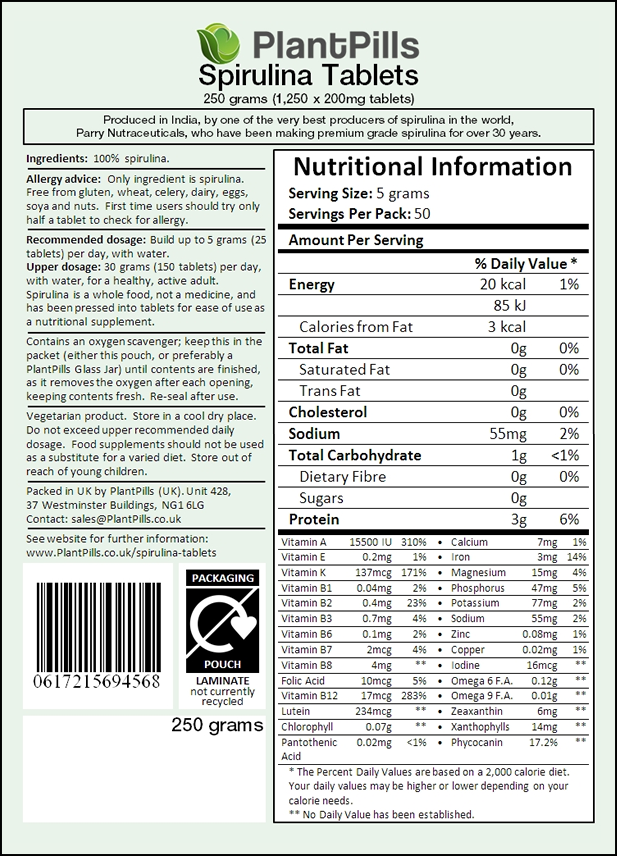
Spirulina tablets are more suited to those that do not like the taste of spirulina powder, or those who take it on the move, and can’t easily measure and mix powder into water.
Spirulina powder is more suited to those that have difficulty swallowing tablets, or otherwise find it more convenient to consume as a drink.
From a scientific perspective, powder offers a much higher surface area available immediately higher up in the digestive tract, which may result in increased or more efficient absorption of some nutrients.
Anyone who has a seafood allergy may be particularly sensitive to spirulina.
Most people will experience detox symptoms when first taking spirulina.
Spirulina contains iodine, to which some may be allergic.
Spirulina contains phenylalanine. The genetic disorder phenylketonuria (PKU) is the inability to metabolize phenylalanine. Individuals with this disorder are known as "phenylketonurics" and must regulate their intake of phenylalanine.
PlantPills spirulina is amongst the most nutritious in the world, so if you are switching from using a different brand of spirulina, it would be sensible to take half your normal dose to begin with and adjust the dosage from there.
Spirulina contains B vitamins which are linked to increased energy. Some people may experience difficulty in sleeping if taking a large dose of spirulina just before bed.
It is easier on the digestive system to take spirulina separately from milk or other dairy products such as yoghurt or cheese.
Persons taking the blood-thinning drug known as Coumadin (generic warfarin) are advised to completely avoid spirulina, or use caution and follow the advice of their healthcare professional because spirulina contains high amounts of vitamin K that may affect the inhibition of blood clots.
Spirulina may cause the immune system to become more active, and this could increase the symptoms of autoimmune diseases. If you have one of these conditions, it’s best to avoid using spirulina.
It is never advisable to start taking a new food supplement such as spirulina during pregnancy.
Superfoods For Optimum Health: Chlorella and Spirulina,Mike Adams
Spirulina - Scientific Review on Usage, Dosage, Side Effects,Examine.com, Kurtis Frank
A randomized study to establish the effects of spirulina in type 2 diabetes mellitus patients. Lee EH, Park JE, Choi YJ, Huh KB, Kim WY (2008), Nutr Res Pract 2(4) 295-300
A randomized double-blind, placebo-controlled study to establish the effects of spirulina in elderly Koreans. Park HJ, Lee YJ, Ryu HK, Kim MH, Chung HW, Kim WY (2008), Ann Nutr Metab 52(4) 322-328
Preventive effect of Spirulina maxima on the fatty liver induced by a fructose-rich diet in the rat, a preliminary report. González de Rivera C, Miranda-Zamora R, Díaz-Zagoya JC, Juárez-Oropeza MA (1993), Life Sci 53(1) 57-61
Effects of dietary Spirulina maxima on vasomotor responses of aorta rings from rats fed a fructose–rich diet. Paredes-Carbajal MC, Torres-Durán PV, Rivas-Arancibia S, Zamora-González J, Mascher D, Juárez-Oropeza MA (1998), Nutr Res 18(10) 1769-1782
Antioxidant properties of Spirulina platensis may partly contribute to antitoxic effects against nephrotoxicity, cardiotoxicity, ovary toxicity, and metal-induced toxicity as well as antiviral and immune-enhancing effects. Avdagic et al. 2008; Grawish et al., 2010; Karadeniz et al., 2008; Karaka et al., 2007; Khan et al., 2005, 2006; Kumar et al., 2009; Lu et al., 2010; Simsek et al., 2009; Zaccaro et al., 2004
Preventative effects of Spirulina platensis on skeletal muscle damage under exercise induced oxidative stress. Lu, H.K., Hsieh, C.C. Hsu, J.J., Yang, Y.K., & Chou, H.N. (2006). European Journal of Applied Physiology 98 (2): 220–226
Enhancement of Antibody Production in Mice by Dietary Spirulina platensis. Hayashi, O., et al., Nutr Sci Vitaminol 40.5 (1994) : 431-41.
Effects of Spirulina platensis on Plasma Lipoprotein Lipase Activity in Fructose-Induced Hyperlipidemic Rats. Iwata, K., et al., J Nutr Sci Vitaminol 36.2 (1990) : 165-71.
Inhibition of Tumor Invasion and Metastasis by Calcium Spirulan (Ca-SP), a Novel Sulfated Polysaccharide Derived from a Blue-Green Alga, Spirulina platensis. Mishima, T., et al., Clin Exp Metastasis 16.6 (1998) : 541-50.
Large scale nutritional supplementation with spirulina alga. C.V. Seshadri . 1993. All India Coordinated Project on Spirulina. Shri Amm Murugappa Chettiar Research Center (MCRC) Madras, India.
Means to normalize the levels of immunoglobulin E, using the food supplement Spirulina. L. Evets, et al. 1994. Grodenski State Medical Univ. Russian Federation Committee of Patents and Trade. Patent (19)RU (11)2005486. Jan. 15, 1994. Russia.
Observations on the utilization of spirulina as an adjuvant nutritive factor in treating some diseases accompanied by a nutritional deficiency. V. Fica, et al. 1984. Clinica II Medicala, Spitalui Clinic, Bucuresti. Med. Interna 36 (3). Romania. (In Romanian)
Influence of extensive training on the number of erythrocytes and hemoglobin level and its correction. Z. Trojacanec et al. 1998 . Institute for Medical, Experimental and Applied Physiology, Faculty of Medicine, Skopje, Macedonia. Pub in XXIV FIMS World Congress of Sports Medicine, June 1998.
Clinical experiences of administration of spirulina to patients with hupochronic anemia. T. Takeuchi, et al. 1978. Tokyo Medical and Dental Univ. Japan.
Cholesterol lowering effect of spirulina. N. Nayaka, et al. 1988. Tokai Univ. Pub. in Nutrition Reports Int'l, Vol. 37, No. 6, 1329-1337. Japan.
The role of cortical glutamate in obsessive-compulsive disorder and attention-deficit hyperactivity disorder, two phenomenologically antithetical conditions. Carlsson, M.L. Acta Psychiatr. Scand. 2000 Dec; 102(6): 401-13; erratum, Acta Psychiatr. Scand. 2001 Jul; 104(1): 80
The Effects of Super Blue Green Algae. Sevulla, I., Aguiree, N. 1995. Managua, Nicaragua: Universidad Centro Americano
The effects of Spirulina on anemia and immune function in senior citizens. Selmi C, Leung PS, Fischer L, et al. Cell Mol Immunol. 2011 Jan 31.
Preventive effects of Spirulina platensis on skeletal muscle damage under exercise-induced oxidative stress. Lu et al (2006), Eur J Appl Physiol, 98: 220-226
Ergogenic and Antioxidant Effects of Spirulina Supplementation in Humans. Kalafati et al (2009), Medicine & Science in Sports & Exercise, 42: 142-151
Efficacy of Spirulina Supplementation on Isometric Strength and Iso-metric Endurance of Quadriceps in Trained and Untrained Individuals – a comparative study. Sandhu et al (2010), Ibnosina Journal of Medicine and Biomedical Sciences, 2: 79-86
Spirulina for gene preservation Qishen et al., 1989; Zhang et al., 2001; Prekumar et al., 2004; Chamorro et al., 2006; Prekumar et al., 2001
Dietary supplementation with blueberries, spinach, or spirulina reduces ischemic brain damage. Wang Y, Chang CF, Jenny Chou J, Chen HL, Deng X, Harvey BK, Cadet JL, Bickford PC (2005), Exp Neurol 193(1) 75-84
Preventive effect of Spirulina maxima on the fatty liver induced by a fructose-rich diet in the rat, a preliminary report. González de Rivera C, Miranda-Zamora R, Díaz-Zagoya JC, Juárez-Oropeza MA (1993), Life Sci 53(1) 57-61
Spirulina for malnutrition. Deng et al., 2010; Habib et al., 2008; Seshadriet al., 1993; Habib et al., 2008; Seshadriet al., 1993
Effects of a Spirulina-Based Dietary Supplement on Cytokine Production From Allergic Rhinitis Patients. TK Mao, et al. Journal of Medicinal Food, 2005 Spring; 8(1): 27-30
Ergogenic and Antioxidant Effects of Spirulina Supplementation in Humans. M. Kalafati, et al. Medicine and Science Sports and Exercise, Jan 2010, 42(1); 142-51
Improvement of Mercuric Chloride-Induced Testis Injuries and Sperm Quality Deteriorations by Spirulina platensis in Rats. El-Desoky GE, et al. PLoS One. (2013)
Spirulina Promotes Stem Cell Genesis and Protects against LPS Induced Declines in Neural Stem Cell Proliferation. Adam D. Bachstetter, Jennifer Jernberg, Andrea Schlunk, Jennifer L. Vila, Charles Hudson, Michael J. Cole, R. Douglas Shytle, Jun Tan, Paul R. Sanberg, Cyndy D. Sanberg, Cesario Borlongan, Yuji Kaneko, Naoki Tajiri, Carmelina Gemma, and Paula C. Bickford. PLoS One. 2010; 5(5): e10496.
The Green Foods Bible. David Sandoval
Spirulina - World Food: How this micro algae can transform your health and our planet. Robert Henrikson
Spirulina in Human Nutrition and Health. M. E. Gershwin, Amha Belay
Earl Mindell's Vitamin Bible. Earl Mindell and Hester Mundis
Healing with Whole Foods. Paul Pitchford
A-to-Z Guide To Supplements. James F. Balch M.D.
Herbal Medicine, Healing & Cancer. Dr. Donald R. Yance, Jr.
Spirulina Nature's Superfood. Kelly Moorhead, Bob Capelli, Gerald Cysewski, PhD
Algae the most complete food, the first form of life on earth and a source of nutrition and vitality., Susan M. Aubrey
The Role of Parry Organic Spirulina in Health Management , Swati S. Thomas
The Role of Parry Organic Spirulina in Radiation Protection, Praneel Datla and Swati S. Thomas
Spirulina: The amazing superfood you've never heard of, Dr. Mercola
GRAS Document, FDA, USA
What the United Nations says about Spirulina, IIMSAM
Intergovernmental Institution for the use of Micro-algae Spirulina against Malnutrition (IIMSAM)
Spirulina-The Amazing Algae (50min) - Screener (3min), Exoptron HD, YouTube
Foods High in Gamma-Linolenic Acids, Cher Martinetti
BCAA/EAA supplementation, Derek Charlebois
Antioxidant-rich diets reduce brain damage from stroke, new preclinical study suggests, NIH, VA, USF Collaborate
David Wolfe speaks about spirulina, YouTube
Improved growth rates, survival and palatability, less fecal and feed waste and less medication in fish., Ronald Henson, Spirulina Algae Improves Japanese Fish Feeds, Aquaculture Magazine December 1990
Nourish yourself with the ultimate superfood, Dave Gabriele
Add Spirulina to Your Diet and Replace those Expensive Supplements, Barbara L. Minton
Discover the radiation protective benefits of Spirulina and Chlorella, Ethan A. Huff
NutritionData (nutritional quantities and values for foods)
* Works best when you enter other keywords too (such as an illness or activity); typing spirulina skeletal muscle into PubMed will return the study performed that found spirulina to preserve skeletal muscle under exercise-induced oxidative stress.

To purchase the PlantPills Spirulina Tablets and Powder, please see the desktop version of this page here.
